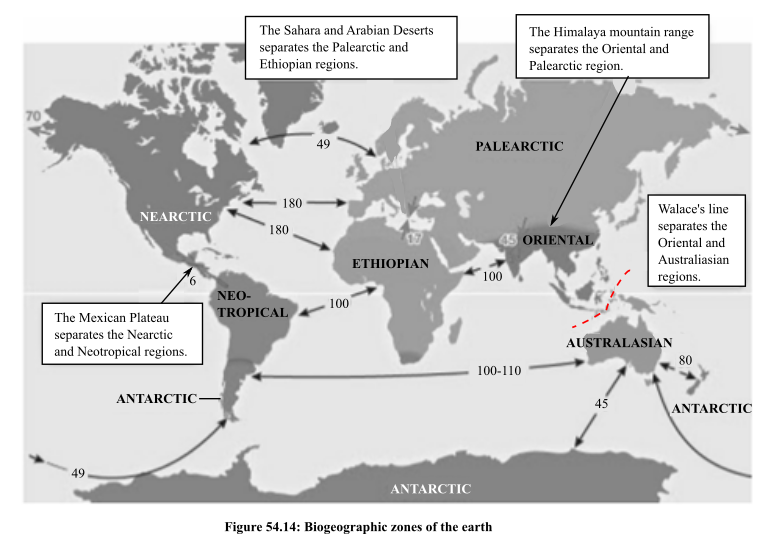
Life: The Science of Biology
11th Edition
ISBN: 9781319010164
Author: David E. Sadava, David M. Hillis, H. Craig Heller, Sally D. Hacker
Publisher: W. H. Freeman
expand_more
expand_more
format_list_bulleted
Concept explainers
Question
Chapter 53.4, Problem 2R
Summary Introduction
To review:
The way in which Wallace’s line helped in explaining the control of the formation of biogeographic regions.
Given:

Figure 1: Biogeographic zones of the earth
Introduction:
On the basis of climate and topography, Wallace divided the earth into six regions, each having its unique biodiversity (Figure 1). These regions are known as biogeographic zones, which are Palearctic, Ethiopian, Oriental, Australasian, Nearctic, and Neotropical.
Expert Solution & Answer
Want to see the full answer?
Check out a sample textbook solution
Students have asked these similar questions
Use this diagram to answer questions 6-7
Outgroup
Cow
Deer
Hippo
Pig
Peccary
Camel
Whale
(b)
Outgroup
Cow
Deer
Whale
Hippo
Pig
Peccary
Camel
6. According to the rule of maximum parsimony, is it MORE LIKELY that whales lost their
hooves or that pigs, deer, cattle, and camels independently gained hooves?
7. Phylogenetic trees can change depending on which trait or gene sequence you use to
classify the organisms (see the diagram above). How is this possible? Hint: you can use the
terms mosaic evolution or haplotype in your answer
If American cacti and African spurges were closely related, could they be used to show that biogeography supports evolution?
Look at picture attached
A) What does the phylogeny suggest about the evolutionary process that led to the trait differences by habitat?
a. convergent evolution
b. adaptive radiation
c. phenotypic plasticity
B) Choose different functional forms from two of the habitats shown in the collage and describe how one or more differences in form may represent an adaptation to their different environment. Example: compare plant form for lobeliads in montane bog to cloud forest understory
Chapter 53 Solutions
Life: The Science of Biology
Knowledge Booster
Learn more about
Need a deep-dive on the concept behind this application? Look no further. Learn more about this topic, biology and related others by exploring similar questions and additional content below.Similar questions
- Based on the morphology of Opalina and Volvox, which supports the syncytial hypothesis and colonial hypothesis of animal origin? please explain well and do not copy from googlearrow_forwardWhat does the trunk of the classic phylogenetic tree represent? a. single common ancestor b. pool of ancestral organisms c. new species d. old speciesarrow_forwardWhat is adaptive radiation? Explain with an example.arrow_forward
- How do we know how old a fossil is? A) We compare it to current species and see how much has changed B) We see how much soil is on top of it C) We use radiometric datingarrow_forwardBelow is a type of evolutionary tree. Which species is O closely related to?arrow_forwardDescribe the time line of appearances of different types of organisms on earth.arrow_forward
- Explain your answer in some depth and avoid just saying "It is A" or It is B. Defend your answer and explain why you choice that answer choice. Question: Domestic dogs would least likely meet the definition of a single species using which concept? Group of answer choices A) Lineage B) Biological C) Morphological D) Domestic dogs are not a single species according to any of the species concept definitions.arrow_forwardWhy don’t shared ancestral characters provide evidence for relationships between organisms within a taxon that has those traits? Give an example.arrow_forwardWhat is the correct order of appearance in the fossil record, starting with the earliest: eukaryotic cells, multicellular organisms, prokaryotic cells?arrow_forward
- Where in a phylogenetic tree would you expect to find the organism that had evolved most recently? a. at the base b. within the branches c. at the nodes d. at the branch tipsarrow_forwardExplain the evidence that our species originated in Africa.arrow_forwardThrough which of the following sequences did chemical evolution MOST likely take place? Protobionts, chemical compounds, organic molecules, complex organic molecules, reproducing cells Protobionts, reproducing cells, chemical compounds, organic molecules, complex organic molecules Chemical compounds, organic molecules, complex organic molecules, protobionts, reproducing cells Chemical compounds, organic molecules, complex organic molecules, reproducing cells, protobiontsarrow_forward
arrow_back_ios
SEE MORE QUESTIONS
arrow_forward_ios
Recommended textbooks for you
 Human Anatomy & Physiology (11th Edition)BiologyISBN:9780134580999Author:Elaine N. Marieb, Katja N. HoehnPublisher:PEARSON
Human Anatomy & Physiology (11th Edition)BiologyISBN:9780134580999Author:Elaine N. Marieb, Katja N. HoehnPublisher:PEARSON Biology 2eBiologyISBN:9781947172517Author:Matthew Douglas, Jung Choi, Mary Ann ClarkPublisher:OpenStax
Biology 2eBiologyISBN:9781947172517Author:Matthew Douglas, Jung Choi, Mary Ann ClarkPublisher:OpenStax Anatomy & PhysiologyBiologyISBN:9781259398629Author:McKinley, Michael P., O'loughlin, Valerie Dean, Bidle, Theresa StouterPublisher:Mcgraw Hill Education,
Anatomy & PhysiologyBiologyISBN:9781259398629Author:McKinley, Michael P., O'loughlin, Valerie Dean, Bidle, Theresa StouterPublisher:Mcgraw Hill Education, Molecular Biology of the Cell (Sixth Edition)BiologyISBN:9780815344322Author:Bruce Alberts, Alexander D. Johnson, Julian Lewis, David Morgan, Martin Raff, Keith Roberts, Peter WalterPublisher:W. W. Norton & Company
Molecular Biology of the Cell (Sixth Edition)BiologyISBN:9780815344322Author:Bruce Alberts, Alexander D. Johnson, Julian Lewis, David Morgan, Martin Raff, Keith Roberts, Peter WalterPublisher:W. W. Norton & Company Laboratory Manual For Human Anatomy & PhysiologyBiologyISBN:9781260159363Author:Martin, Terry R., Prentice-craver, CynthiaPublisher:McGraw-Hill Publishing Co.
Laboratory Manual For Human Anatomy & PhysiologyBiologyISBN:9781260159363Author:Martin, Terry R., Prentice-craver, CynthiaPublisher:McGraw-Hill Publishing Co. Inquiry Into Life (16th Edition)BiologyISBN:9781260231700Author:Sylvia S. Mader, Michael WindelspechtPublisher:McGraw Hill Education
Inquiry Into Life (16th Edition)BiologyISBN:9781260231700Author:Sylvia S. Mader, Michael WindelspechtPublisher:McGraw Hill Education

Human Anatomy & Physiology (11th Edition)
Biology
ISBN:9780134580999
Author:Elaine N. Marieb, Katja N. Hoehn
Publisher:PEARSON

Biology 2e
Biology
ISBN:9781947172517
Author:Matthew Douglas, Jung Choi, Mary Ann Clark
Publisher:OpenStax

Anatomy & Physiology
Biology
ISBN:9781259398629
Author:McKinley, Michael P., O'loughlin, Valerie Dean, Bidle, Theresa Stouter
Publisher:Mcgraw Hill Education,

Molecular Biology of the Cell (Sixth Edition)
Biology
ISBN:9780815344322
Author:Bruce Alberts, Alexander D. Johnson, Julian Lewis, David Morgan, Martin Raff, Keith Roberts, Peter Walter
Publisher:W. W. Norton & Company

Laboratory Manual For Human Anatomy & Physiology
Biology
ISBN:9781260159363
Author:Martin, Terry R., Prentice-craver, Cynthia
Publisher:McGraw-Hill Publishing Co.

Inquiry Into Life (16th Edition)
Biology
ISBN:9781260231700
Author:Sylvia S. Mader, Michael Windelspecht
Publisher:McGraw Hill Education
Evidence for Evolution - Biogeography; Author: Viced Rhino;https://www.youtube.com/watch?v=304wIG6H11E;License: Standard YouTube License, CC-BY